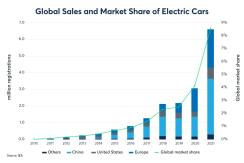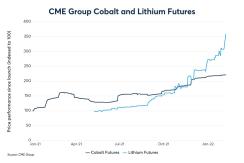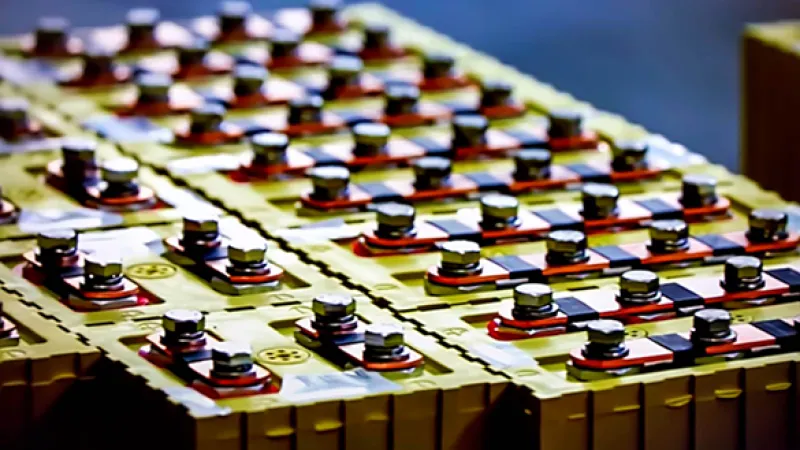By Gregor Spilker, CME Group
AT A GLANCE
- Electric vehicle sales in China and the U.S. saw triple digit growth in 2021, placing higher demands on cobalt and lithium production.
- Cobalt and lithium futures prices have more than doubled since launching in December 2020 and May 2021, respectively.
In total, 6.6 million EVs were sold this past year, amounting to nearly 10% of the global market. China is the largest market for EVs, with sales increasing 179% to 3.4 million new car registrations and thereby overtaking Europe at 2.3 million units (+64% year over year). While smaller than China or Europe, the American EV market also showed strong growth, increasing 123% year over year to 700,000 units.

Seen in a wider context, higher EV penetration is part of the transition to a low carbon economy. This transition is gathering pace as world leaders are signing up to emission reductions and net-zero targets. As has been widely commented, the decarbonization of transport and energy generation will require a significant amount of metal – aluminum, copper, nickel, cobalt and lithium could all be in high demand.
The IEA estimates that demand for lithium may increase up to fortyfold in 20 years’ time, and demand for cobalt could increase by a factor of 20-25 if governments across the globe reach the goals set out in the Paris Agreement. There is a level of uncertainty around the exact growth rates – since these are influenced by evolving technology as well as governmental climate policies – but it is hard to imagine a scenario where cobalt and lithium markets do not grow to accommodate the energy transition.
Lithium and Cobalt Futures Performance
CME Group offers trading in both cobalt and lithium futures. It launched a cobalt metal contract in December 2020 and a lithium hydroxide contract in May 2021. Since launching, prices in both contracts have trended higher. Cobalt is now trading at $34/kg, more than twice the level it was at launch. Lithium prices have increased even faster, from $13/kg in May 2021 to above $40 in February 2022.
In the case of lithium, prices rose as supply was not able to keep up with rampant demand. And that is despite lithium supply increasing 22% from 2020 to 2021 according to S&P Global Market Intelligence - the same firm also forecast demand for lithium chemicals to increase to 641,000 metric tons in 2022, a near 30% increase versus 2021 levels. Naturally, current prices incentivize new production to come online. Producers have not failed to respond and announced mining expansions as well as new greenfield developments across the globe. However, it takes time for commercial activities to ramp up. New lithium material that is destined for batteries needs to get tested and qualified – a process that can take up to 18 months according to Fastmarkets.
In 2021, supply chain issues impacted the cobalt market. The majority of world production is mined in the Democratic Republic of the Congo and shipped via South Africa, making South African ports a critical bottleneck in the global supply chain. In the past year, South Africa was hit by civil unrest and the Omicron covid wave, as well as the ongoing shipping delays that are impacting global commodity markets.
This presented challenges on the supply side. Demand from the battery sector was strong, but less than it may have been due to changes in battery chemistry preferences. Increased production of lithium-iron -phosphate batteries at the expense of nickel-cobalt-manganese production reduced the demand for cobalt. In absolute terms, battery demand for cobalt is set to continue growing, with Benchmark Mineral Intelligence expecting over 30% annual growth supported by new EV model launches and government legislation. In addition, non-battery demand for cobalt, most notably from the aerospace sector, is recovering and contributed to the positive price momentum in 2021.
As shown by their price performance, both cobalt and lithium have benefited from strong tailwinds in 2021 and have continued to increase in early 2022. It seems clear that both metals are critical to meet growing EV demand and satisfy large-scale efforts to move from the internal combustion engine to battery powered transportation.
Read more articles like this at OpenMarkets






